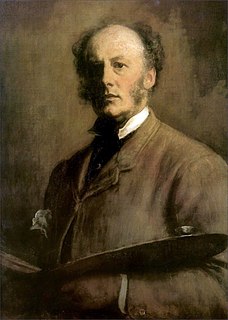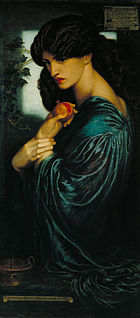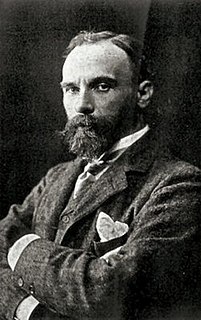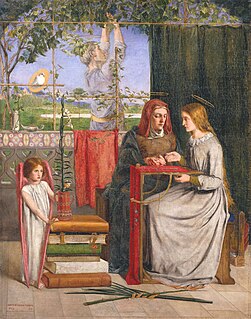
Sir John Everett Millais, 1st Baronet, was an English painter and illustrator who was one of the founders of the Pre-Raphaelite Brotherhood. He was a child prodigy who, aged eleven, became the youngest student to enter the Royal Academy Schools. The Pre-Raphaelite Brotherhood was founded at his family home in London, at 83 Gower Street. Millais became the most famous exponent of the style, his painting Christ in the House of His Parents (1849–50) generating considerable controversy, and he produced a picture that could serve as the embodiment of the historical and naturalist focus of the group, Ophelia, in 1851–52.

The Pre-Raphaelite Brotherhood was a group of English painters, poets, and art critics, founded in 1848 by William Holman Hunt, John Everett Millais, Dante Gabriel Rossetti, William Michael Rossetti, James Collinson, Frederic George Stephens and Thomas Woolner who formed a seven-member "Brotherhood" modelled in part on the Nazarene movement. The Brotherhood was only ever a loose association and their principles were shared by other artists of the time, including Ford Madox Brown, Arthur Hughes and Marie Spartali Stillman. Later followers of the principles of the Brotherhood included Edward Burne-Jones, William Morris and John William Waterhouse.

John William Waterhouse was an English painter known for working first in the Academic style and for then embracing the Pre-Raphaelite Brotherhood's style and subject matter. His artworks were known for their depictions of women from both ancient Greek mythology and Arthurian legend.

Ophelia is a painting by British artist Sir John Everett Millais, completed in 1851 and 1852 and in the collection of Tate Britain in London. It depicts Ophelia, a character from William Shakespeare's play Hamlet, singing before she drowns in a river in Denmark.

Simeon Solomon was a British painter associated with the Pre-Raphaelites who was noted for his depictions of Jewish life and same-sex desire. His career was cut short as a result of public scandal following his arrests and convictions for attempted sodomy in 1873 and 1874.

Edward Robert Hughes was a British painter, who primarily worked in watercolours, but also produced a number of oil paintings. He was influenced by his uncle and artist, Arthur Hughes who was associated with the Pre-Raphaelite Brotherhood, and worked closely with one of the Brotherhood's founders, William Holman Hunt.

Echo and Narcissus is a 1903 oil painting by John William Waterhouse. It illustrates the myth of Echo and Narcissus from Ovid's Metamorphoses.

Mary Magdalene is a Pre-Raphaelite oil on panel painting by Frederick Sandys, executed in 1858–1860. Mary Magdalene was the only figure from the Bible that Sandys ever painted. Having sharp features reminiscent of Lizzie Siddal, Mary is depicted in front of a patterned forest-green damask. She holds an alabaster ointment cup, a traditional attribute which associates her with the unnamed sinful woman who anointed Jesus' feet in Luke 7:37. Like other Pre-Raphaelite painters, Frederick Sandys gave Magdalene a sensual look.

The Lady of Shalott is a painting of 1888 by the English painter John William Waterhouse. It is a representation of the ending of Alfred, Lord Tennyson's 1832 poem of the same name. Waterhouse painted three versions of this character, in 1888, 1894 and 1915. It is one of his most famous works, which adopted much of the style of the Pre-Raphaelite Brotherhood, though Waterhouse was painting several decades after the Brotherhood split up during his early childhood. The Lady of Shalott was donated to the public by Sir Henry Tate in 1894 and is usually on display in Tate Britain, London, in room 1840.

Mariana is an 1851 oil-on-panel painting by John Everett Millais. The image depicts the solitary Mariana from William Shakespeare's Measure for Measure, as retold in Tennyson's 1830 poem "Mariana". The painting is regarded as an example of Millais's "precision, attention to detail, and stellar ability as a colorist". It has been held by Tate Britain since 1999.

Tate Britain, known from 1897 to 1932 as the National Gallery of British Art and from 1932 to 2000 as the Tate Gallery, is an art museum on Millbank in the City of Westminster in London, England. It is part of the Tate network of galleries in England, with Tate Modern, Tate Liverpool and Tate St Ives. It is the oldest gallery in the network, having opened in 1897. It houses a substantial collection of the art of the United Kingdom since Tudor times, and in particular has large holdings of the works of J. M. W. Turner, who bequeathed all his own collection to the nation. It is one of the largest museums in the country. The museum had 391,595 visitors in 2020, a drop of 78 per cent from 2019 due to COVID-19 pandemic closures, but still ranked 52nd on the list of most-visited art museums in the world.

The Awakening Conscience (1853) is an oil-on-canvas painting by the English artist William Holman Hunt, one of the founders of the Pre-Raphaelite Brotherhood, which depicts a woman rising from her position in the lap of a man and gazing transfixed out of the window of a room.

Joanna Mary Boyce was a British painter associated with the Pre-Raphaelite Brotherhood. She is also known by her married name as Mrs. H.T. Wells, or as Joanna Mary Wells. She produced multiple works with historical themes, as well as portraits and sketches, and authored art criticism responding to her contemporaries. She was the sister of Pre-Raphaelite watercolourist George Price Boyce.

Ecce Ancilla Domini, or The Annunciation, is an oil painting by the English artist Dante Gabriel Rossetti, first painted in 1850 and now in Tate Britain in London. The Latin title is a quotation from the Vulgate text of the first chapter of the Gospel of Saint Luke, describing the Annunciation, where Mary accepts the message brought to her by the Angel Gabriel that she would give birth to a child (Jesus) by God.

Proserpine is an oil painting on canvas by English artist and poet Dante Gabriel Rossetti, painted in 1874 and now in Tate Britain. Rossetti began work on the painting in 1871 and painted at least eight separate versions, the last only completed in 1882, the year of his death. Early versions were promised to Charles Augustus Howell. The painting discussed in this article is the so-called seventh version commissioned by Frederick Richards Leyland, now at the Tate Gallery, with the very similar final version now at the Birmingham Museum and Art Gallery.

Saint Eulalia is an oil painting on canvas in the Pre-Raphaelite style, created in 1885 by English artist John William Waterhouse, depicting the aftermath of the death of Eulalia of Mérida. It is currently housed at Tate Britain.

I Am Half-Sick of Shadows, Said the Lady of Shalott is a painting by John William Waterhouse completed in 1915. It is the third painting by Waterhouse that depicts a scene from the Tennyson poem, "The Lady of Shalott". The title of the painting is a quotation from the last two lines in the fourth and final verse of the second part of Tennyson's poem:

Fanny Eaton was a Jamaican-born artist's model and domestic worker. She is best known as a model for the Pre-Raphaelite Brotherhood and their circle in England between 1859 and 1867. Her public debut was in Simeon Solomon's painting The Mother of Moses, which was exhibited at the Royal Academy in 1860. She was also featured in works by Dante Gabriel Rossetti, John Everett Millais, Joanna Mary Boyce, Rebecca Solomon, and others.

The Girlhood of Mary Virgin is an 1849 oil on canvas painting by the Pre-Raphaelite Brotherhood painter Dante Gabriel Rossetti, measuring 83.2 by 65.4 cm and now in the collection of Tate Britain, to which it was bequeathed in 1937 by Agnes Jekyll. It was his first completed oil painting and is signed "Dante Gabriele Rossetti P.R.B. 1849". He first exhibited it at the 'Free Exhibition' at the Hyde Park Corner Gallery.






















